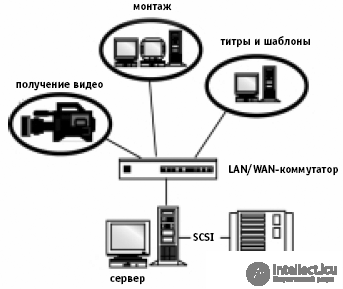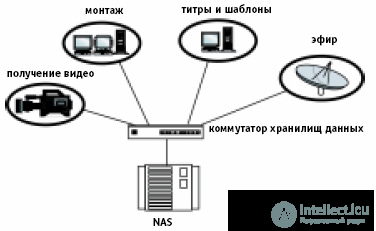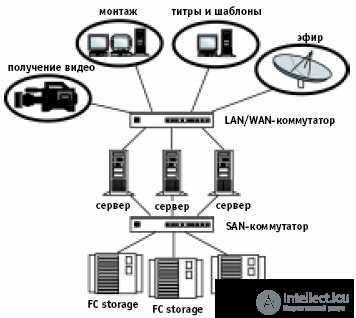Lecture
The pace of development of high-end corporate IT-systems has recently become avalanche-like. The cost of memory, hard drives, processors, and consequently, highly reliable servers, clusters and storage systems is constantly decreasing. Now informational solutions, which previously could only be used by large banks and industrial companies, became available for television and radio companies of various levels.
The purpose of this review is to introduce data storage technologies that have been tested in large enterprises and can be used in the preparation of television programs and television broadcasting. The introduction of such systems greatly simplifies the process of preparing programs, reduces the workload of personnel, improves the quality of materials, and, most importantly, makes the process of forming a video broadcast more transparent and reliable.
From a technical point of view, modern television is a complex production, the main criteria of effectiveness of which are efficiency, reliability and maximum quality with minimum investment. The improvement of these indicators has been facilitated by the widespread introduction of non-linear editing technologies, which initially involve working with video and audio materials in digital format. The next step in the development of television technology is the use of data storage systems. Today, there are three topology data storage systems: SAS / DAS, NAS, SAN. In this article we will talk about the main differences, the hardware used in their implementation, and the options for practical use in television.
SAS / DAS
SAS (Server Attached Storage) or DAS (Direct Attached Storage) - storage systems connected directly to the server. They use the traditional way of connecting the storage system to a high-speed server interface, usually a parallel SCSI interface.
The terms SAS and DAS define the same concept, just different manufacturers use different names for marketing reasons, which is why confusion arises. Therefore, in this article, these storage systems are united under the general name SAS / DAS.
The main advantage of the storage system connected to the server over other options is their low cost and high speed (based on one storage system for one server). This topology is optimal when using a single server through which access to the data array is organized. But, since in this case, a number of problems still remain, the designers were forced to look for other options for organizing access to storage systems.

SAS Storage System
SAS / DAS | |
Virtues | disadvantages |
| Low cost | Data access depends on the OS and file system. |
| High speed within one server | The complexity of the organization of systems with high availability |
| Reduced response speeds when loading the storage system server | |
SAS / DAS systems in television can be used to create data storage systems for a cluster, mobile data storage systems of large volumes and as disk arrays for building NAS, SAN.
Cluster systems with SAS / DAS are used to organize highly reliable output of the mounted material on the air, high-speed data processing, to build a system of archives and archiving, i.e. at those stages of the production process, which are characterized by increased criticality to speed and fault tolerance.
NAS
NAS (Network Attached Storage) is a network attached storage system. This type of access appeared relatively recently; its main advantage is the convenient integration of additional storage into existing networks, although it does not introduce any radical changes to the storage architecture. In fact, NAS in many ways resembles a clean file server, and today you can find quite a few new implementations of NAS storage systems based on thin server technology (Thin Server)
An important difference between the NAS and the file server is that the latter uses the traditional operating system (UNIX, Windows), which has increased functionality. The file server can be used to organize mail, web and other servers, it has no specialization and can perform many functions that are redundant in writing / reading, lead to a significant decrease in system reliability and to increased delays in data processing. The OS for NAS is designed to provide the most rapid and reliable data handling, often using the Linux or Windows operating system with the appropriate tuning. Such an OS does not need to be additionally adjusted for the network, as a rule, it is enough to set the IP address, and the NAS is ready for operation. This allows the administrator to avoid configuration errors, leads to standardization of the storage system and reduces maintenance to very simple operations.

NAS storage system
NAS | |
Virtues | disadvantages |
| Data access is independent of the OS and platform. | Low scalability |
| Ease of administration | Traffic conflict |
| Easy installation | LAN / WAN |
NAS on most parameters is ideal for organizing work on television and provides file sharing. Any user of the network can get to the file he needs and perform the necessary operations from any location on the network, while the cost of its ownership is rather low. A high-level NAS even allows you to mount video without copying to a user's workstation, although in this case there are limitations associated with the bandwidth of the local network.
The use of NAS systems in television complexes opens up great opportunities for collaboration, allows you to organize transparent work for the whole creative team with a step-by-step algorithm, when everyone knows what and when he will need to prepare and insert into the final product (sound, narration text, special effects, and .d.)
SAN
SAN (Storage Area Network) is a storage area network. Such networks began to develop intensively and be introduced only since 1999. The basis of the SAN is a separate network from LAN / WAN, which serves to provide access to the data of servers and workstations involved in their direct processing. Such a network is created based on the Fiber Channel standard, which makes it possible to realize in the data storage systems the advantages of LAN / WAN technologies and the possibility of organizing standard platforms for systems with high availability and demand rates. Almost the only drawback of SAN today is the relatively high price of components, although the total cost of ownership for enterprise systems built using storage area network technology is quite low.
It should be noted that the SAN technology is still quite new and in the near future it will have to undergo many improvements in the field of management standardization and how SAN subnetworks interact. The advantages of SAN include almost all of its features, and the disadvantages - the high cost.
SAN | |
Virtues | disadvantages |
| Topology independence from storage and server arrays | Design complexity |
| Convenient centralized management | Installation complexity |
| No conflict with LAN / WAN traffic | High starting cost |
| Convenient data backup without loading the local network and servers | |
| High speed | |
| Scalability | |
| Flexibility | |
| High Availability and Resiliency | |
The use of SAN on television is justified only when the network extends to the entire process of preparing television programs and television. Otherwise or with limited financial capabilities, it is better to use NAS (the difference will be only in the speed of working with data). Great advantages in the speed of the SAN system as a whole are provided by the absence of a conflict with the LAN / WAN traffic.
A successful example of SAN implementation on television is Fiber Channel SAN on YAM1 TV channel. It was built on the basis of two host-independent FibreArray HI 12 arrays, FC Switch Vixel V7100 optical concentrators and FC HBA QLA2200F controllers that provide 1 Gbps two-way data transfer speed / s per port. This system was designed in the research department of the company "Yustar".

SAN storage network
The introduction of data storage systems on television is not a fad, but a natural process. The use of NAS or SAN storage systems greatly simplifies work on the final material, provides non-linear access to video and audio archives for members of the creative team, and allows you to stream directly from data arrays. Work with the film is limited only by the primary distillation of the footage into the system, and everything else is already done in the storage system. And such a time-consuming and responsible work, like the release of programs on the air, is reduced to the compilation of a broadcasting sheet, which is not much more difficult than a similar process in WinAmp. At the same time, all the problems traditional for film air studios are excluded.
If it annoys you that the video engineer has to rewind the tape back and forth for a long time to search for a single frame, then it’s time to think about data storage systems. Thanks to such a system, the working team will be able to concentrate on creative activity, will receive a reliable and friendly tool for the preparation of programs and the air, besides, it will be possible to save on various tape-carrying mechanisms.
Comments
To leave a comment
Electromechanical devices of electronic devices
Terms: Electromechanical devices of electronic devices